I recently took a wonderful trip to Madagascar and decided to share the experience, and some lemur pictures, here.
Madagascar is unique, beautiful and primitive. The fourth largest island in the world, Madagascar split from the Indian subcontinent about 88 million years ago where native plants and wildlife then evolved in relative isolation. An astonishing 90% of Madagascar’s wildlife is found nowhere else on Earth!
My favorite Madagascar wildlife is the lemur. Many people think of the lemur as one species, however, there are actually close to 100 known species, only on this special island. I, of course, did not see all of them, but my tour group was able to spot 17 different species during our two-week stay.
Lemurs are primates, and some are very shy, making snapshots difficult. Photo credit for most of these pictures goes to Robbin Merritt, a member of our touring group and a wonderfully skilled photographer. I do take credit for the exceptional lighting at night (I held the flashlight, LOL).
The Smallest: Mouse Lemurs
Mouse lemurs are the smallest primates in the world. It is estimated that all 24 known species of mouse lemur evolved from a common ancestor 10 million years ago. Unfortunately, mouse lemurs are nocturnal, meaning, we had to brave the night and the jungle (with our local guide) to help us find these elusive creatures. We began our walks right after sunset for a quick dart into the jungle and then back, and were able to get back to the lodge in time for dinner. The mouse lemur species we found are as follows:
Gray Mouse Lemur
Where seen: Ifaty
We stayed at Le Paradisier Hotel, and many people spotted mouse lemurs in trees hanging about their bungalows. I saw one on a night walk, but was unable to get a picture.
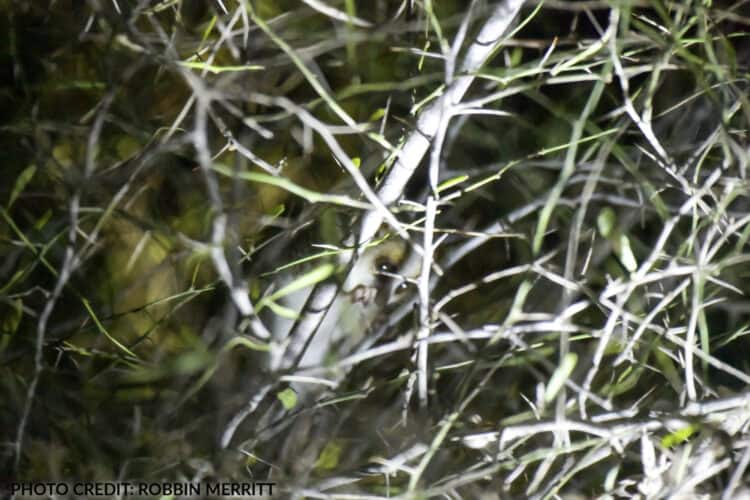
Mostly, we saw their shining eyes reflected in our flashlights. 😀
Brown Mouse Lemur
Where seen: Ranomafana
We had greater success when we stayed at the Setam Lodge when our local guide took us on a nocturnal walk along the road. The road would seem counterintuitive to see these elusive animals, but our guide had a trick, or banana, up his sleeve: He smeared banana on tree branches and the hungry lemurs were more than happy to take advantage of the treat.

This lemur is also known as the "Rufous Mouse Lemur"
Goodman’s Mouse Lemur
Where seen: Andasibe
At this location we stayed at the Mantadia Lodge. Again, a local guide took us on a nocturnal walk along the road, this time without using the banana trick, relying instead on physics. The guide explained that after sundown insects are attracted to the heat retained by the pavement, which in turn attracts the omnivorous lemurs to feed.
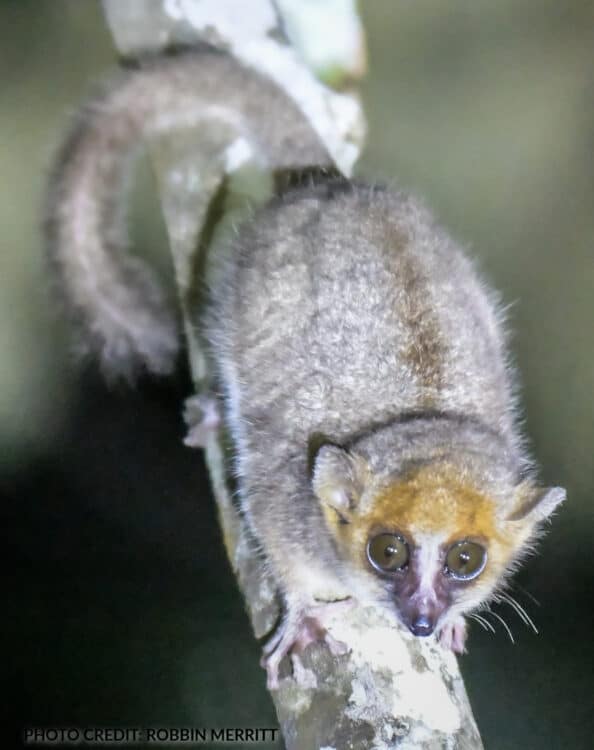
The average size of a Goodman's Mouse Lemur is 45-48 grams (less than 2 oz).
Medium sized lemurs
I am grouping together the mid-sized lemurs, which include the most recognized types.
Sportive Lemur spp
Where seen: Ifaty (Spiny Forest)
The sportive lemur (no, he doesn’t wear Jordans) is nocturnal, so we felt fortunate to see one of these during the day. He was high up in a tree so our guide was not able to determine which specific species (of the 26 known) we were observing.
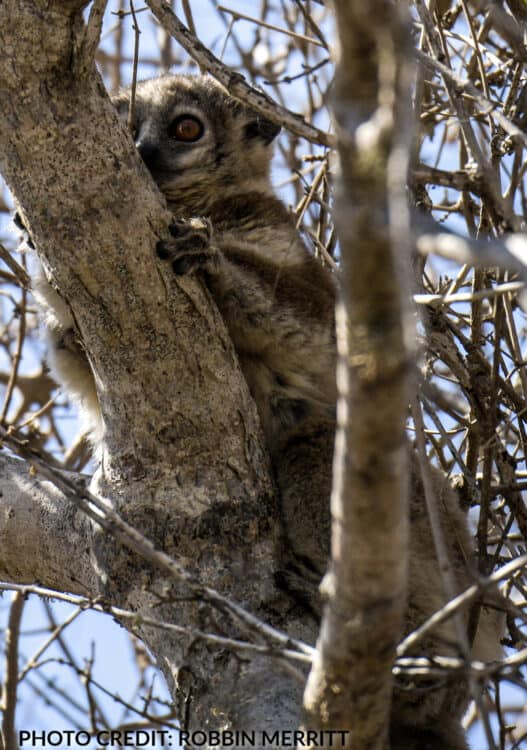
I think ”sporty” just wanted us to leave so he could resume his nap. 😃
Zombitse Sportive Lemur
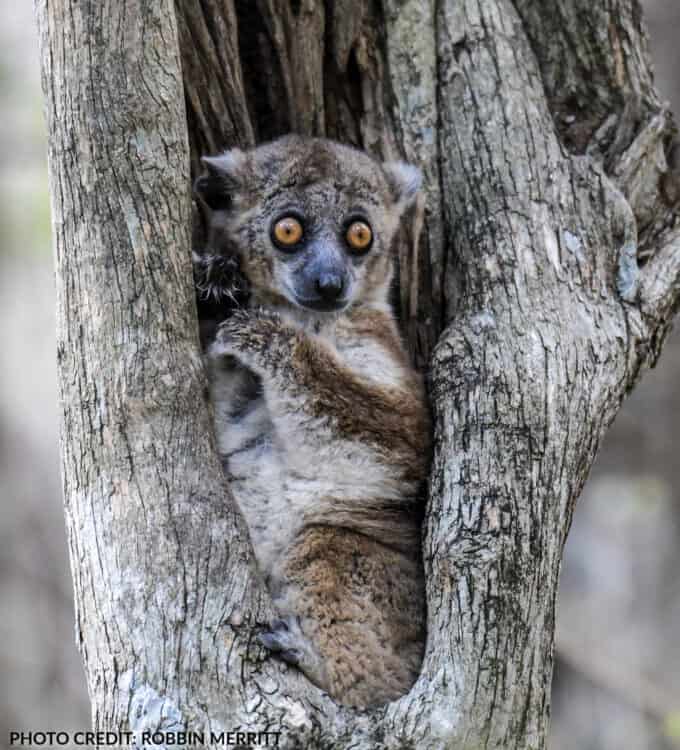
This is another nocturnal sportive that probably just wanted to go back to sleep. My expression is probably similar before I've had my first cup of coffee.
Common Brown Lemur
These guys are charming! We had the opportunity to observe a family group interacting in a treetop. A baby lemur would venture away from mama for just a short walk along the branch, then lose courage and scamper back to safety. I and another member of our group felt they deserved a better name than “Common”, so we named them: “Uncommon Mocha Lemur.” I’m expecting this to catch on any day now...
I took this video of mom and baby in the VOIIMA community reserve, near Andasibe
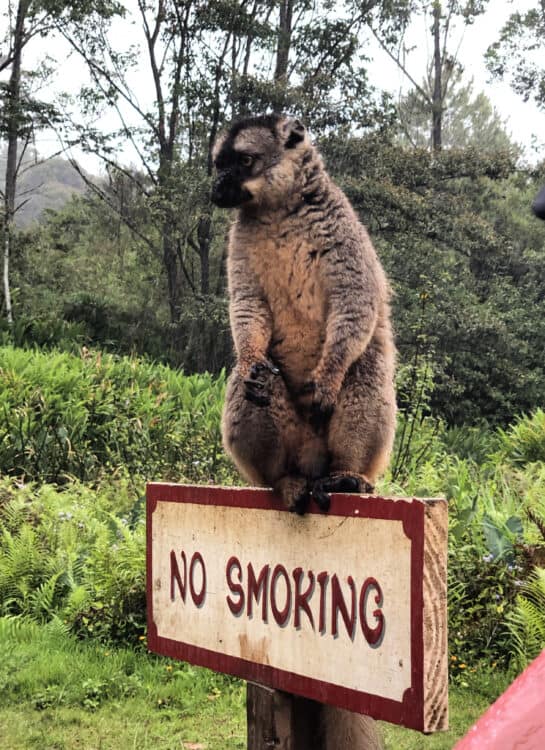
The newly named Uncommon Mocha Lemur (Common Brown Lemur, sigh) is found all over Madagascar. They’re most friendly and acclimated to humans in a place called Vakona Lemurs Island. This guy greeted us as we got off the boats.
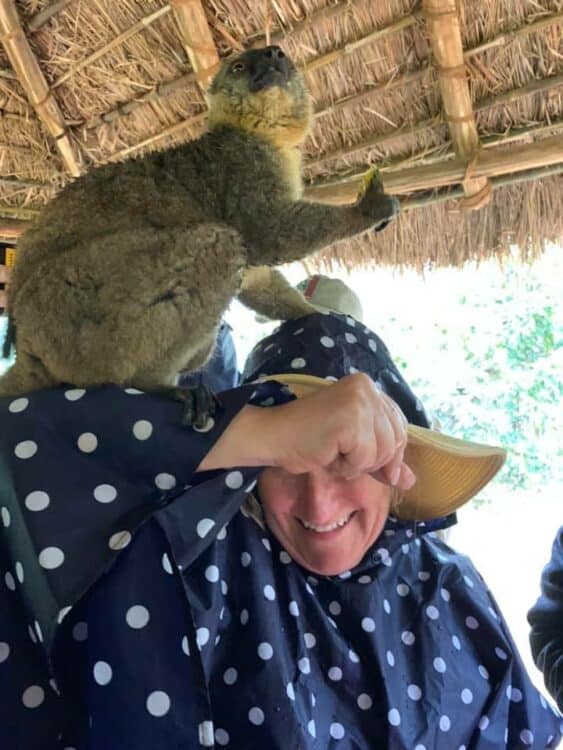
Incredibly, they are known to jump on visitors (!) in hopes of getting a banana snack. What fun!
Ring-Tailed Lemur
To most of us, the Ring-Tailed Lemur is the most recognized because these guys are often featured in nature movies like – what else? “Madagascar,” the popular Dreamworks animated movie. These lemurs are found in the southern part of Madagascar. We saw ring-tailed lemurs in Isalo National Park as well as in the Anja Community Reserve.
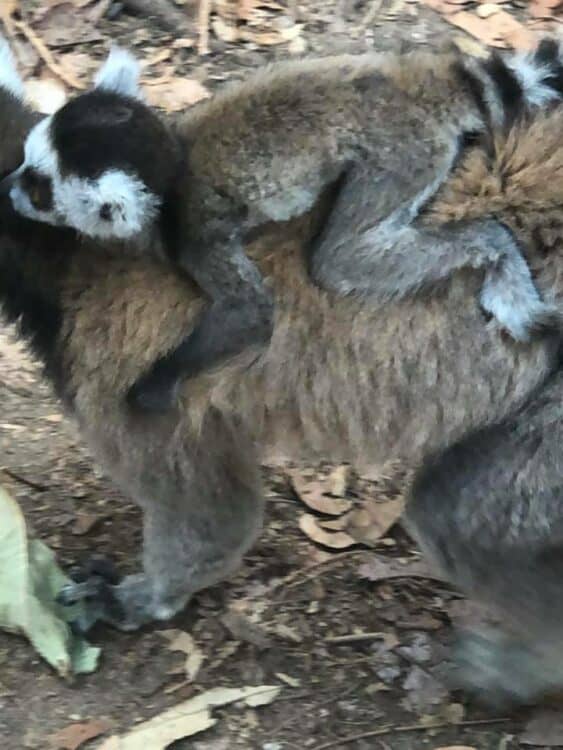
What I found most remarkable was how blasé they were around humans. In fact, this mama walked right past me on the trail, with baby in tow. Adorable!
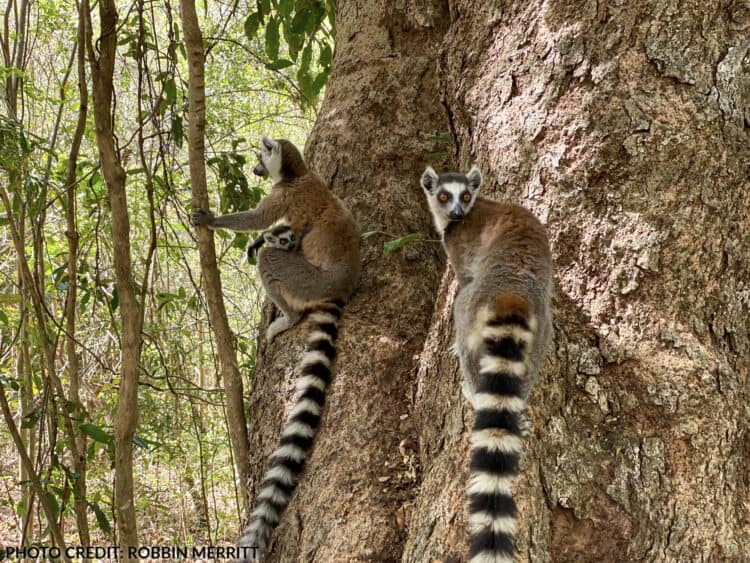
This lemur species reminds me the most of a cat or fox, with its alert, curious expression and graceful movements. Of course, their eyes are much larger than a cat’s and their tails are even longer than their bodies.
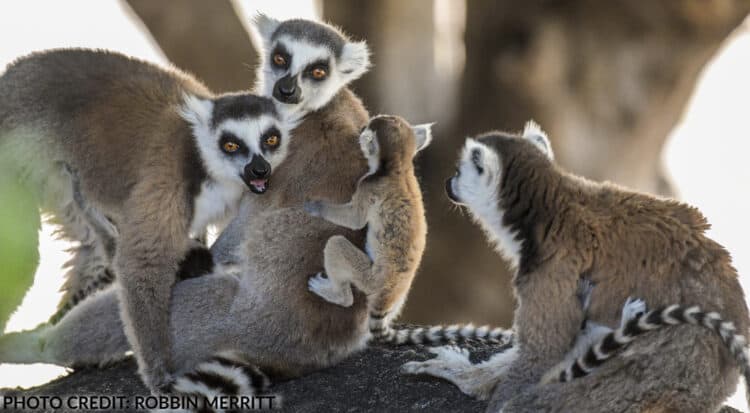
Ring-tailed lemurs are very sociable. We never saw one in isolation, always in a group, and often with babies hitching a ride.
These groups are female dominant, which, of course, is as it should be. 😄
Red Ruffed Lemur
Where seen: Vakona Lemur Island
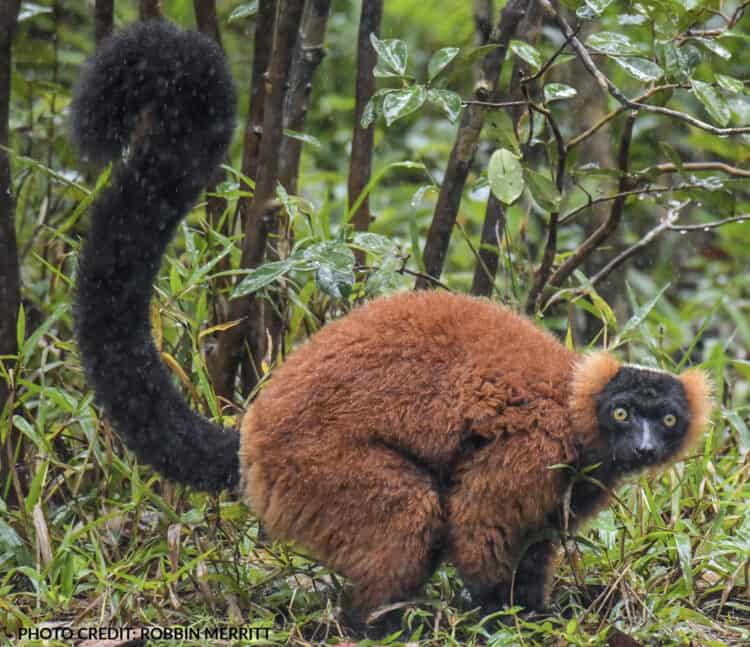
This lemur was actually out of place. They are native to the northeast part of Madagascar. But this lonely fella currently resides alone on a small island, separate from the other lemurs on Lemur Island. So beautiful and unusual. I felt sorry for this guy.
Black and White Ruffed Lemur
This lemur, in particular, is critically endangered living in the eastern rainforests of Madagascar. Not surprisingly, the biggest threat to the survival of this species is man. 😟
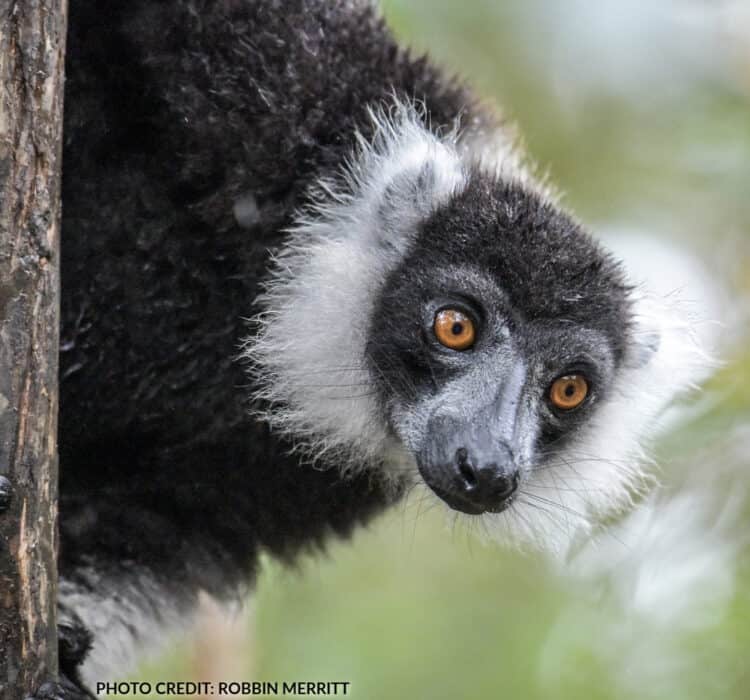
This lemur is primarily a fruit eater. Groups are dominated by females, perhaps to give females feeding priority to successfully reproduce.
Sifaka
The lemurs known as Sifaka are sometimes referred to as “dancing lemurs” due to their unique movement: While other lemurs walk on four feet, the Sifaka use their two back feet to hop on the ground with their forelimbs held upright for balance, kind of like a square dancer looking for a partner. I briefly saw this “dance” and I was surprised at how quickly they moved!
The Sifaka has a round hairless face that is always black. The family name is an onomatopoeia (a word that sounds like what it’s describing, i.e. “BOOM!”) characteristic of their vocal alarm: “shi-fak” (SHEE- FAK!!).
Verreaux's Sifaka

We spotted Verreaux’s Sifaka in Zombitse as well as in Isalo National Park
Diademed Sifaka
This Diademed Sifaka (aka Golden Sifaka) was seen in Andasibe. (Note: A diadem is a headband or crown). I love the golden color on this one.
Indri Indri
This is the largest species of lemur still in existence, weighing up to 21 pounds. A larger, now-extinct species once reached the size of a gorilla (Lesson for the day: The big guys don’t always win). These lemurs, the only ones to have a nub of a tail, are revered by the Malagasy people because of their human-like characteristics.
Many legends surround the Indri, or “babakoto” in the Malagasy. One legend tells of a man who went hunting in the forest and did not return. His absence worried his son, who went out looking for him. When the son also disappeared, the rest of the villagers ventured into the forest seeking the two, but discovered only two large lemurs sitting in the trees: the first indri. The boy and his father had transformed. In some versions, only the son transforms, and the wailing of the babakoto is analogous to the father’s wailing for his lost son.
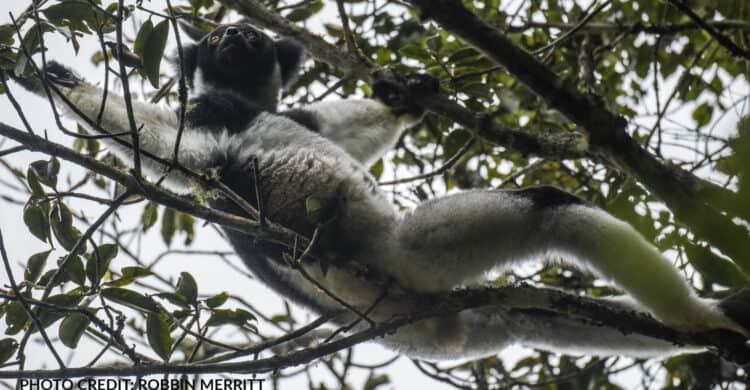
The Indri form monogamous relationships and live in small family groups.
Besides this human-like behavior, they entertain us by sun-bathing. Each morning, they will sit and face the sun from a tree branch, eyes-half closed, legs crossed, back straight, and hands low with palms facing out or resting on its knees. While biologists are hesitant to associate this behavior with humans, many Malagasy believe that the Indri worship the sun.
Most striking, and sadly unsurprising was the observation made by our guide about the effects of captivity on the Indri. No Indri has ever been successfully bred in captivity, all have died within a year of capture. Notably, according to our guide, the Indri, when captive, appears to be crying. 😔
Overall, it seemed to me that our best sightings of lemurs happened in national parks and conservation areas. It seems that awareness has been growing of the need to conserve habitat for these rare and special creatures. Hopefully these efforts of conservationists and the beliefs of the Malagasy will protect these beautiful animals in their natural habitat for many years to come.
My next adventure? I'm thinking a road trip to see more of this beautiful country of ours. One thing for sure, I will be investing in some packing cubes - my Madagascar roommate had these and I loved how organized it made her suitcase! I found these and even more ideas in Best Road Trip Gifts for Travelers. Check it out!





Texasgirl
Great and interesting Blog! Who doesn’t love Lemurs
Sula
They are adorable!